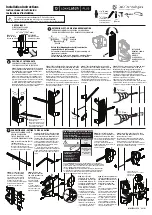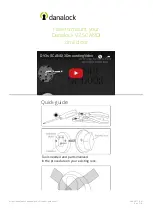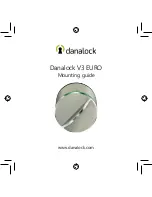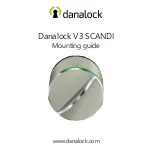
D
POSITION OF LATCH ON GATE
POSICIÓN DEL CERROJO EN LA PUERTA
POSITION DU LOQUET SUR LE PORTILLON
DETERMINE LEFT- OR RIGHT-HANDED MOUNTING
DETERMINE EL MONTAJE A LA DERECHA O A LA IZQUIERDA
CHOISIR L’OUVERTURE À DROITE OU À GAUCHE POUR LE MONTAGE
1
2
Installation Instructions
LLINSTR0039PA 8/11/21
Instrucciones de instalación
3
1
/
2
”
(90 mm)
5
/
32
” (4 mm)
1
/
2
” (13 mm)
#
2
#
2
Instructions d’installation
5
/
8
” (16 mm)
For vinyl & wood
Para vinilo y madera
Pour vinyle et bois
3
⁄
8
”–1
1
⁄
16
” (10-27 mm)
GAP VARIANCE:
DIFERENCIA DE ESPACIO:
ÉCART D’ESPACEMENT :
GATE FRAME
Marco de puerta
Cadre de portillon
FENCE POST
Poste de verja
Poteau de clôture
LEFT
IZQUIERDA
GAUCHE
RIGHT
DERECHA
DROITE
Rotate (flip) Mounting Bracket (A) to obtain the
required Left or Right handing
Rote (voltee) el soporte de montaje (A) para su montaje a la
izquierda o a la derecha.
Faire pivoter (le retourner) le support de montage (A) pour
obtenir une ouverture vers la gauche ou vers la droite.
A
Step 1:
Determine the height of latch on the fence
post. Use the Mounting Bracket (A) as a fitting jig
to mark the side of post, aligning with the lower
notch on the Bracket as shown.
Paso 1: determine la altura del cerrojo en el poste de verja.
Utilice el soporte de montaje (A) como plantilla de ajuste
para marcar el canto lateral del poste, alineándolo con la
muesca inferior del soporte como se muestra en la imagen.
1
ère
étape : Fixer la hauteur du loquet sur le poteau de
la clôture. Utiliser le support de montage (A) comme
gabarit pour marquer le côté du poteau, en l’alignant sur
l’encoche inférieure du support, comme indiqué.
Step 2:
Slide the Mounting Bracket down so that the
center notch now aligns with your marked line. Mark
that point on the post face, which will be
3
⁄
4
” (19mm)
in from the outer edge.
Paso 2: deslice el soporte de montaje hacia abajo para que
su muesca central quede alineada con la línea marcada.
Marque el punto situado en el soporte de montaje, dicho
punto debe quedar a 3⁄4” (19 mm) hacia adentro del canto
lateral del poste.
2
ème
étape : Faire glisser le support de montage vers le bas
de sorte que l’encoche centrale s’aligne maintenant avec la
ligne qui a été tracée. Marquer ce point sur le poteau, à 19
mm (3/4”) du bord extérieur.
Step 3:
Take the Mounting Bracket around to
the opposite side of post and mark the opposing
point, being sure to again align with the center
notch on the Bracket.
Paso 3: coloque el soporte de montaje en el lado opuesto del
poste y marque el punto opuesto, asegurándose de alinearlo
con la muesca central del soporte.
3
ème
étape : Placer le support de montage sur le côté
opposé du poteau puis marquer le point opposé en
s’assurant de l’aligner à nouveau sur l’encoche centrale
du support.
3
⁄
4
”
(19 mm)
CONNECTING ROD: CUTTING TO SIZE & SEATING
3
Step 1:
Insert Connecting Rod (B)
through fence post.
Paso 1: inserte la varilla de conexión
(B) a través del poste de la verja.
1
ère
étape : insérer la tige de connexion
(B) à travers le poteau de la clôture.
B
Step 2:
Slide the Rod so that the pointy
end aligns flush with the outside of the
post, as shown below. Mark the Rod on
the opposite side of post and remove.
Paso 2: deslice la varilla de modo que el
extremo puntiagudo quede enrasado con la
parte externa del poste, como se muestra
en la imagen. Marque la varilla en el lado
opuesto del poste y retírela.
2
ème
étape : faire glisser la tige de sorte que
l’extrémité pointue s’aligne sur l’extérieur du
poteau, comme illustré ci-dessous. Marquer
la tige sur le côté opposé du poteau puis la
retirer.
Note the lower notch on side of
Mounting Bracket
Observe la muesca inferior en el
costado del soporte de montaje.
Noter la fente inférieure sur le
côté du support de montage.
A
Side face
of post
Front face
of post
Step 4:
Insert the Rod into the
External Access Push-Button (C)
housing until it snaps into place.
Paso 4: inserte la varilla en el botón de
acceso externo (C) hasta que encaje
en la posición adecuada.
4
ème
étape : insérer la tige dans le
logement du bouton-poussoir d’accès
externe (C) jusqu’à ce
qu’elle s’enclenche.
C
Step 5:
Insert the connected unit so that
the rod slides fully through the post. Fix it in
place using four screws.
Paso 5: inserte la unidad conectada para que la
varilla se deslice por completo a través del poste.
Fíjela en el lugar con los cuatro tornillos.
5
ème
étape : insérer l’unité connectée de sorte que
la tige glisse complètement à travers le poteau. La
fixer en place à l’aide de quatre vis.
Step 7:
Depress the
push-button so that the
sawn Rod protrudes out
from the post.
Paso 7: pulse el botón
para que la varilla
cortada sobresalga
del poste.
7
ème
étape : appuyer
sur le bouton-poussoir
pour que la tige sciée
dépasse du poteau.
Step 8:
Position the
Latch Body (D) so that the
protruding rod slots into the
corresponding interface (E) -
see below - and then mount
the Body with four screws.
Paso 8: coloque el cuerpo del
cerrojo (D) para que la parte de
varilla que sobresale se encaje
en el punto de conexión (E)
correspondiente - ver imagen -
y luego fije el cuerpo con cuatro
tornillos.
8
ème
étape : positionner le corps
du verrou (D) de sorte que la
tige en saillie se place dans
l’interface correspondante (E)
- voir ci-dessous - puis fixer le
corps à l’aide de quatre vis.
E
For child safety gates use the MagnaLatch
®
‘Top Pull’ Gate Latch.
Para puertas de seguridad para niños, utilice los cerrojos MagnaLatch®
Utiliser le verrou de portillon MagnaLatch
®
pour les barrières de sécurité pour enfants
5
⁄
32
” (4 mm)
1
⁄
2
” (13 mm)
Step 4:
Drill holes through post, starting with pilot
holes of
5
⁄
32
” (4mm) on both sides of the post.
With pilot holes complete, enlarge the holes by
redrilling with the larger
1
⁄
2
” (13mm) drill bit.
Paso 4: taladre agujeros en el poste, omenzando con agujeros
guía de 5⁄32” (4 mm) en ambos lados del poste. Una vez
completados los agujeros guía, agrande los agujeros volviendo
a taladrar con una broca de 1⁄2” (13mm).
4ème étape : percer des trous dans le poteau, en
commençant par les avant-trous de 4 mm (5/32”) des deux
côtés du poteau. Une fois les trous percés, agrandir ceux-ci
à l’aide d’un foret plus grand de 13 mm (17/32”).
Step 9:
Take the Striker Body
(F) and, centering the bolt in
the middle of the tongue slot,
fix it with four more screws,
being sure to mount the
screws in the center of the
slots.
Paso 9: tome el cuerpo del cerradero
(F) y, centrando el perno en
el centro de la ranura de la lengüeta,
fije el cuerpo del cerrojo con otros
cuatro tornillos, asegurándose de
centrarlos en las ranuras laterales.
9
ème
étape : prendre le corps de
la gâche (F) puis, en centrant le
verrou au milieu de la fente de
la languette, la fixer avec quatre
autre vis, en veillant à monter les
vis au centre des fentes.
D
F
Center screws in slots
Centre los tornillos en los orificios.
Centrer les vis
dans les fentes
LEFT-HANDED
MOUNTING SHOWN
Step 6:
Use the four small
screws to secure Mounting
Bracket to the Latch Body.
Paso 6: utilice los cuatro tornillos
pequeños para fijar el soporte de
montaje al cuerpo del cerrojo.
6
ème
étape : utiliser les quatre petites
vis pour sécuriser le support de
montage au corps du verrou.
IMAGEN CON
MONTAJE
A LA IZQUIERDA
MONTAGE À GAUCHE
ILLUSTRÉ
Paso 3: IMPORTANTE para el correcto funcionamiento del cerrojo. Marque la
varilla de conexión ‘B’ a la profundidad exacta del poste de verja (pared exterior).
Corte la varilla ‘B’ recta y a escuadra sobre una superficie plana. Lime las aristas
rugosas o afiladas para asegurar un ajuste correcto.
3e étape : IMPORTANT pour le bon fonctionnement du loquet. - Marquer la tige
de connexion «B» à la profondeur exacte du poteau de clôture (mur extérieur).
- Couper la tige «B» droite et carrée sur une surface plane. Retirer les bords
rugueux ou tranchants pour assurer un réglage correct.
SIDE (depth) of post
Lado (profuxndidad)
del poste
Côté (profondeur)
du poteau
B
POST
Poste
Poteau
Accurately cut to depth of post.
CUT PRECISELY.
Corte con precisión a la
profundidad del poste.
Découpé avec précision à la
profondeur du poteau.
Step 3:
IMPORTANT
for correct latch function
-
Mark connector rod ‘B’ to the exact depth of the
fence post (outer wall).
- Cut rod ‘B’ straight and square on a flat surface.
- Remove rough or sharp edges to ensure correct fit.
VARILLA DE CONEXIÓN: CORTE A
MEDIDA Y COLOCACIÓN
TIGE DE CONNEXION : COUPE
SELON LES DIMENSIONS ET APPUI




















